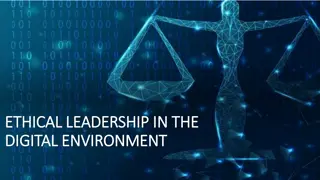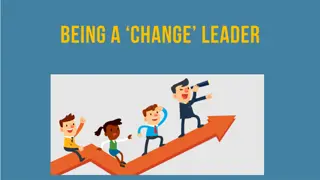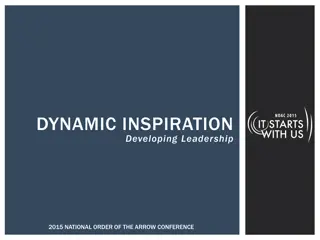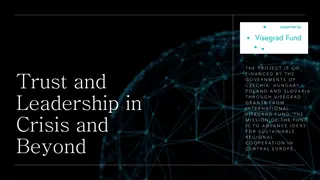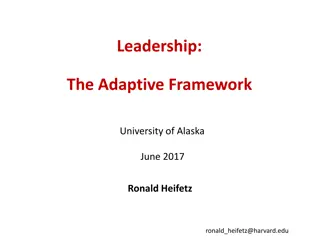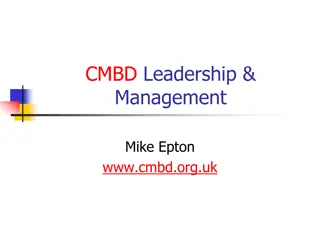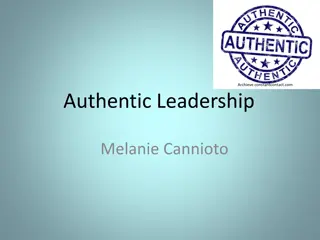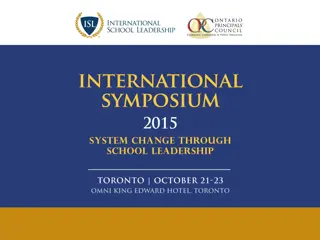Understanding Leadership and Environment Relationship
Leadership in the context of the environment involves influencing individuals or groups towards common goals while considering the impact on the surrounding ecosystem. A leader is defined by their ability to inspire, motivate, and lead by example. The concept of environmental leadership emphasizes the core values of sustainability, empathy, and vision. This article explores the intersection of leadership and environmental stewardship, highlighting the importance of translating vision into reality for sustainable development.
Download Presentation

Please find below an Image/Link to download the presentation.
The content on the website is provided AS IS for your information and personal use only. It may not be sold, licensed, or shared on other websites without obtaining consent from the author. Download presentation by click this link. If you encounter any issues during the download, it is possible that the publisher has removed the file from their server.
E N D
Presentation Transcript
LEADERSHIP AND ENVIRONMENT The Basics of Leadership in Environment Presented by Onuoha Sarah
Outline Who is a leader? What is Leadership? Definition of leadership Definition of Environment. Concept of environmental Leadership Core values of an environmental leader. Relationship between Leadership and sustainable development Conclusion
Who is a Leader? A leader is a person who influences a group of people towards the achievement of a goal. A leader is also someone who does more than just leading people. They have to be driven by the right motivation and make a positive impact on the people around them. A leader is someone who can see how things can be improved and who rallies people to move toward that better vision. Leaders can work toward making their vision a reality while putting people first. Just being able to motivate people isn t enough leaders need to be empathetic and connect with people to be successful. Leaders don t have to come from the same background or follow the same path. A leader by its meaning is one who goes first and leads by example, so that others are motivated to follow him. Below is a diagram that describes a good leader. I call it the 3p s which are; Person, People and Purpose.
The 3ps of a leader PURPOSE PEOPLE PERSON Influences
Definition of Leadership Leadership is both a research area and a practical skill encompassing the ability of an individual, group or organization to lead, influence, or guide other individuals, teams or entire organizations. Leadership is a matter of intelligence, trustworthiness, humaneness, courage, and discipline. Reliance on intelligence alone results in rebelliousness. Leadership is also a process of social influence, which maximizes the efforts of others, towards the achievement of a goal. Leadership is the capacity to translate vision into reality Warren Bennis The NOTs of Leadership Leadership has nothing to do with seniority or one s position in hierarchy of a company. Leadership doesn t automatically happen when you reach a certain pay grade or about how old you have been in an organization or experience you have gotten from the jobs you have done. Leadership has nothing to do with title. Just like a stated above, because you have a hierarchy title in an organization doesn t make you a leader. Leadership has nothing to do with personal attribute, like being charismatic. Leadership isn t management: Managers need to plan, measure, monitor, coordinate, solve, hire, fire, and so many other things. Typically, managers manage things. Leaders lead people.
Definition of Environment Meaning of Environment The word Environment is derived from the French word Environ which means surrounding . Our surrounding includes biotic factors like human beings, Plants, animals, microbes, etc and abiotic factors such as light, air, water, soil, etc. Environment is surroundings or conditions in which a person, animal or plants lives or operate. It is also the circumstances, objects or conditions by which one is surrounded. Environment can also be defined as the complex of physical, chemical and biotic factors (such as climate, soil and living things) that act upon an organism or an ecological community and ultimately determines its form and survival. Components of Environment Our environment has been classified into four major component (Kalavathy, 2004). 1.Hydrosphere :Hydrosphere includes all water bodies such as lakes, ponds, rivers, streams and ocean etc. Hydrosphere functions in a cyclic nature, which is termed as hydrological cycle or water cycle.
2. Lithosphere : Lithosphere means the mantle of rocks constituting the earths crust. The earth is a cold spherical solid planet of the solar system, which spins in its axis and revolves around the sun at a certain constant distance .Lithosphere mainly contains soil, earth rocks, mountain etc. Lithosphere is divided into three layers-crusts, mantle and core (outer and inner). 3. Atmosphere :The cover of the air, that envelopes the earth is known as the atmosphere. Atmosphere is a thin layer which contains gases like oxygen, carbon dioxide etc. and which protects the solid earth and human beings from the harmful radiations of the sun. There are five concentric layers within the atmosphere, which can be differentiated on the basis of temperature and each layer has its own characteristics. These include the troposphere, the stratosphere, the mesosphere, the thermosphere and the exosphere. 4. Biosphere : It is otherwise known as the life layer, it refers to all organisms on the earth s surface and their interaction with water and air. It consists of plants, animals and micro-organisms, ranging from the tiniest microscopic organism to the largest whales in the sea. The richness of biosphere depends upon a number of factors like rainfall, temperature, geographical reference etc. Apart from the physical environmental factors, the man made environment includes human groups, the material infrastructures built by man, the production relationships and institutional systems that he has devised.
Concept of Environmental Leadership Leadership has shifted focus from the individual to group or institutes. Efforts to link leadership and the natural environment have already begun and the necessity for environmental leadership has never been higher than ever in the era of complex and evident environmental and social problems, such as climate change, global conflict, limited resources, an overwhelming amount information, etc. Environmental leaders who promote environmental sustainability infuse their desire to protect the natural environment into their decision-making and action processes. Who is an Environmental Leader? An environmental leader is a person who has the ability to make the socioeconomic system more harmonious with the environment through environmentally-friendly products, services, businesses, technologies, and policies. Environmental leaders are those who look at environmental problems in light of their own experience and moral values, are committed to leveraging their area of expertise to realize sustainable development in their professional and private lives, and exercise leadership in fulfilling their social responsibilities. Interviews conducted with more than 200 environmental professionals at universities, companies and NGOs asking for their opinions about environmental leadership revealed that there are mainly three basic building blocks that go into making environmental leaders. These building blocks include commitment, expertise, and leadership. (in an English article by Shamsolyazlie)
The 3 Requirement of Environmental Leadership
Core values of an Environmental Leader Environmental leaders implements and demonstrates environmental sustainability thinking and practice in all aspects of business. Environmental leaders strive to help and improve the communities where they work and live. They are concerned about the environment and promote the use of recyclable products and renewable energy. Accountability and Alignment: They are responsible for their actions and support business decisions through experience and good judgement. They are good team players. Environmental leaders are loyal to people including staffs, care for each other both personally and professionally. Environmental leaders are flexible rather than rigid. They help team members strike a healthy work and life balance. They have integrity and honesty, not compromising the truth. They treat their team members, customers, and partners with mutual respect and sensitivity, recognizing the importance of diversity. They respect all individuals and value their contributions. Environmental leaders have passion for result.
Relationship between Leadership and Sustainable Development. If sustainable development means the insurance of future generation on progress and evolution. The relationship between leadership and sustainable development is very important because there is no development without leadership especially in the social, human and cultural dimension. Sustainable development is the process of developing land , cities and communities, as well as business, provided that meet the needs of the present without compromising the ability of future generations to meet their needs. The world needs effective leadership for sustainable development and this leadership requires an inner process, in which a leader must first be grounded in an understanding of self and a relational view of the world, in order to effectively work with others to make change. To achieve the Sustainable development goals, leadership styles that engender a sense of shared responsibility toward the attainment of the goals, is focused on the long-term, and thus would establish systems that would persistently ensure the pursuance of these goal in the future. Leadership is managing resources, being visionary and ethical, and focus on long-term goals without compromising values and principles which helps to attaining sustainable development.
CONCLUSION In conclusion, leadership in environment is very important for sustainable development in the society at large. For the sustainability of environmental development, environmental leaders are to be considered.
THANK YOU onuohasarai@gmail.com 08060406227

 undefined
undefined




